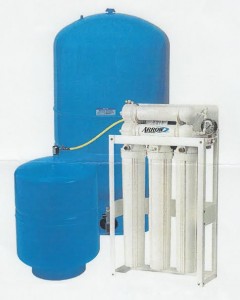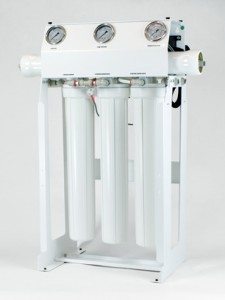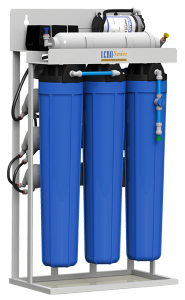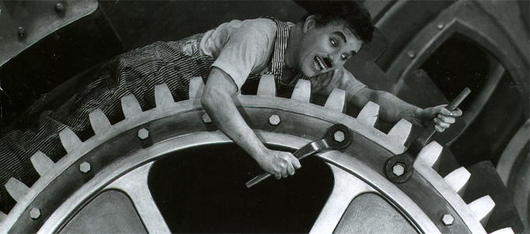The Pure Water Occasional for August 31, 2016
In this deep summer Occasional, you'll hear about aging pipes, lime softening, earthquake prevention, reef bleaching, and the Silent Highwayman. Tnen there are Big Bubba, Filtersorb, the nifty GRO membrane, the Clean Water Act, and the Great Stink of 1858. Also, Glyphosate, the Delta Tunnel, Dog Ridge, TX water issues, microbeads galore, and the increasing stench from the Salton Sea. Read about making beer from urine, campylobacter in New Zealand, rules changes in water polo, the ban on swimming with dolphins, the Papahānaumokuākea Marine National Monument, NAC, light commercial RO units, the Crossness Pumping Station museum, and, as always, there is much, much more.
The Pure Water Occasional is a project of Pure Water Products and the Pure Water Gazette.
To read this issue on the Pure Water Gazette's website, please go here. (Recommended! When you read online you get the added advantage of the Gazette's sidebar feed of the very latest world water news.)
America's Water Supply: The Corrosion of a Proud Tradition
U.S. communities suffer from about a quarter of a million water main breaks every year, mostly due to aging pipe
By Robert Glennon, Aug. 2016.
A common sight in American cities.
The debacle in Flint, Michigan was a betrayal of the public trust at every level of government. The horror of people drinking poisoned water is a microcosm of the sad deterioration of one of America’s greatest accomplishments: the creation of infrastructure to provide virtually universal access to clean water and wastewater treatment.
Across America, water and sewer plants, pipes, and valves are reaching or beyond the end of their useful lives. By failing to invest in maintaining the city’s drinking water infrastructure, Flint officials acted no differently than those in thousands of other communities – high- and low-income – who are neglecting the promise of government that all residents have the right to clean water.
In early twentieth century America, it was not safe to drink water from public taps. Cities routinely dumped raw sewage into nearby rivers, thus causing their downstream neighbors to suffer epidemics of waterborne diseases, such as cholera, dysentery, and typhoid. This practice finally ended after Congress passed the 1972 Clean Water Act, which underwrote the costs of municipal water treatment plants.
In the 1980s, Congress’s taste for funding the construction costs waned, and it created a revolving funds program, which provided low-interest loans to states and cities. That worked pretty well for a while. But, in subsequent decades, spending on water and wastewater infrastructure plummeted. In the aftermath of the Great Recession, the American Recovery and Reinvestment Act of 2009 (Mr. Obama’s stimulus program) devoted only $6 billion out of $800 billion to our water systems. That’s not chump change but the scale of the problem is immense.
Our water infrastructure consists of approximately 54,000 drinking water systems, with more than 700,000 miles of pipes, and 17,000 wastewater treatment plants, with an additional 800,000 miles of pipes. A 2012 report of the American Water Works Association concluded that more than a million miles of these pipes need repair or replacement. That’s why communities across the nation suffer 240,000 water main breaks per year. The major cause of pipe failure is age.
The negative health and environmental effects of decaying water infrastructure, as in Flint, stretch far beyond lead poisoning. Corroding pipes may leach cadmium, copper and iron into drinking water. Leaking pipes compromise water pressure and may induce contaminants to enter the drinking water system. Deteriorating sewer pipes leach fecal matter into aquifers and rivers. Aging treatment plants may fail to remove bacteria, parasites, and endocrine-disrupting compounds. No one knows which communities will be the next Flint; but these potential risks will turn into health crises without aggressive steps to modernize the infrastructure.
Episodes such as Flint undermine the public’s confidence in the safety of their drinking water. As Americans begin to doubt the quality of municipal water, some will opt out, choosing to install expensive water filtration systems in their homes. When more affluent citizens no longer have a stake in maintaining high-quality municipal water, that leaves behind people of more modest means – people without the same influence on elected officials.
The water lost from leaking pipes exceeds seven billion gallons a day. No one has estimated how much cities spent treating this water to drinking water quality. Whatever the amount, it’s lost revenue, never to be repaid by customers. Upgrading our water infrastructure will require substantial capital. Estimates range from $682 billion by the EPA to more than $1 trillion by the American Water Works Association.
Solving this problem presents a daunting challenge that asks us who we are as a people. Do we care enough about our communities to make water infrastructure a priority? It won’t be an easy road: No politician wants to run for reelection on a campaign of having overhauled the sewer system. Yet, recent polls suggest that Americans want public officials to act and are ready to pay more for a secure supply of safe water.
Public officials—local, state, and federal—must devote substantial funds to modernize water and wastewater systems. Congress, in particular, should initiate a new Clean Water Act program to underwrite the costs of municipal water treatment plants and should vastly increase funding for loans to states and cities. State and local governments should issue ultra-long-term government bonds (perhaps for 50 years as European governments have recently done), so that modernization can begin now but the repayment costs spread out over longer periods. Finally, to generate needed funds, one sensible option is to enter public-private partnerships that tap into the capital markets for construction costs in exchange for a system of rates and fees to reimburse the lenders.
Our water and wastewater systems have set the benchmark for the world. We should feel pride in this stunning achievement. Now, we need to summon the resolve to fix the problem and maintain the proud tradition of providing safe, clean water and wastewater treatment to virtually every American.
Robert Glennon is a Regents’ Professor at the University of Arizona and author of Unquenchable: America’s Water Crisis and What To Do About It.
Article Source: Scientific American.
The Pure Water Gazette Famous Water Picture Series
The Silent Highwayman
(Click picture for a larger view.)
Published by Punch magazine in July 1858, "The Silent Highwayman" serves as a grim reminder of the rank state of the River Thames, which in mid-nineteenth century London doubled as open sewer and drinking water source.
"The Silent Highwayman" serves as a reminder of a memorable time in London known as The Great Stink of 1858. The great stink occured as the result of an intense heat wave and a spectacularly inadequate waste disposal system that created a stench of human excrement so noxious that it was said to be unbearable.
It was a time of typhoid and cholera. Londoners distrusted the drinking water, which came from the same river that received the city's raw sewage. One cleric observed: “He who drinks a tumbler of London water has literally in his stomach more animated beings than there are men, women and children on the face of the globe."
The Great Stink episode prompted action and London began work on a monumental sewage disposal system known as the Crossness Pumping Station. Opened on April 4, 1865, during a lavish ceremony attended by British royalty and the top celebrities of London society, the new facility featured four mighty steam engines that pumped the city’s sewage into a 27 million gallon reservoir where it sat covered until high tide at which point it was released into the Thames and carried out to sea. While this approach only exacerbated pollution levels downstream, it certainly proved effective in curing London of the unholy stink that plagued the city for a great part of the 19th century. Improved over the years, the Crossness Pumping station (now a museum) operated for around a hundred years. The original four mighty steam engines were not retired until 1956.
The Crossness Pumping Station is now an impressive museum in London. The four great steam engines, which were given names of royal family members, are on display.
Those who complain today of stricter regulation of water and air quality and increasing water treatment costs should remember that things were once a lot worse. Modern waste water treatment plants not only protect water supplies but are increasingly used to recycle waste water for reuse as potable water. So, quit bitching about increasing water rates. Pay up and be thankful you don't have to live with The Great Stink and fear of cholera.
More information from the Mother Nature Network.
Roundup
Glyphosate, known better as Roundup and sold under several other brand names as well, a product of Monsanto, has been around since 1974. It is a potent and popular herbicide, registered for use in 130 countries. The world consumes more than 720,000 metric tons annually, so there is plenty to get into water. Glyphosate was detected in 36% of stream samples from 9 Midwestern US states as far back as 2002.
Although Roundup has always been viewed with suspicion, there is little evidence that it poses a cancer risk to humans. Recent studies, however, have shown mixed results. Currently, the EPA sets its MCL at 700 parts per billion. The World Health Organization concludes that regulatory guidelines are not necessary because it poses low risk in drinking water.
Despite such assurances, most prefer not drinking Roundup. There are many options for getting rid of it. These include chlorination, ozonation, nanofiltration, reverse osmosis, and filtration with granular activated carbon.
Reference: Water Technology magazine, July, 2016.
The Route Water Takes "From River to Faucet"
An article in an Iowa newspaper ("From River to Faucet") describes the step-by-step process used to process Mississippi River water for drinking in several Iowa cities, including rural Des Moines. Here are the steps.
Water drawn from the river is treated with potassium permanganate, which removes a lot of the taste and odors of river water.
Then, the water is treated with two coagulants: cationic polymer and aluminum sulfate. These separate the water from dirt particles, getting the water closer to the clear liquid that comes out of faucets.
From there, the water is treated with lime, which softens it. [The process referred to is called "lime softening." It is not the equivalent of softening with an ion exchange water softener. The article comments that after the softening process, the water is "still fairly hard."]
From there, the water plant adds fluoride "to prevent tooth decay" and sodium, which helps prevent water from depositing in water mains.
"Sodium also provides a coating to water mains and pipes, helping prevent problems like those in Flint, Mich., where thousands of children were exposed to unsafe amounts of lead. Especially in areas with older houses, such as Flint or Burlington, pipes can be made out of lead and copper, both of which cause health issues if people are exposed to too much of them. Water that travels through those pipes without first being treated can corrode the pipes, sending dangerous chemicals into the water people drink or cook with."
Water finally is treated with chlorine and ammonia as a long-lasting disinfectant before being pumped up for distribution to consumers or storage in a water tower.
Current Water News
The bare bones water news, link free, commercial free.
In Rio, Olympic water event athletes were warned by officials against putting their heads under the water. Canoe sprint, marathon swimming, rowing, sailing, and triathlon all take place in open water that is dangerously polluted. Two canoers from Serbia took a spill in the dirty water on the first day of competition.
California Delta Tunnel officials have decided that they put their billion $ straws in the wrong place.
In the UK, unautorized animal medicinal products were seized from World of Water vets.
Studies show that the decline in salmon began with and resulted from the development of water power in the Middle Ages.
Cornell University will be required to cut back its water use by 30% because the city of Ithaca, NY is running out of water.
New Hampshire officials have banned outdoor water use in 50 towns and cities because of drought conditions.
Researchers at the University of Ghent in Belgium have developed a solar-powered machine that converts urine to drinkable water that is then used to brew beer.
Although Californians used 21.5% less water in June than they did in 2013, usage was up 6% from 2015 due to relaxed regulations.
After restricting oil and natural gas operations in certain hotspots, Oklahoma has an average of two earthquakes a day, compared with about six a day last summer. Kansas has increased restrictions on natural gas operations and is getting about a quarter of the quakes it once did.
The EPA estimates that some 775 municipalities around the country have antiquated combined sewage and stormwater overflow systems. When it rains heavily or snow melts, the systems are overwhelmed and dump untreated sewage and stormwater into rivers and lakes. One city in New York dumps thousands of gallons of untreated sewer discharge into the Hudson River as many as 30 times per year.
An Oregon-based company is using solar technology to reduce Salmonella, E. coli and Listeria contamination in agricultural runoff.
The water supply at Dog Ridge, Texas was cited for multiple drinking water violations.
It was reported that 60 percent of coral reefs in the Maldives have fallen victim to bleaching because of rising sea temperatures.
A single shower using products made with plastic microbeads can result in 100,000 plastic particles entering the ocean. Goverments are being urged by environmentalists to ban plastic microbeads.
Sacred water on a Crow reservation in Montana is contaminated with high levels of uranium.
Researchers found that Gwynns Falls on the western side of Baltimore is contaminated not only with raw sewage from leakage from the city's sewer system but also significant levels of pharmaceuticals and illegal drugs.
An estimated 4,500 people in Havelock North (New Zealand) got sick with a gastrointestinal infection linked to campylobacter bacteria in the town’s water supply. An intrusion of fecal bacteria from livestock was suspected.
Hydgrogen sulfide levels in the Salton Sea continue to rise and the stink rising from the water is definitely on the increase.
The market for activated alumina, used for a variety of purposes in water treatment, including fluoride removal, is expected to reach $1,110 million by 2024.
A German public broadcasting station drew a barrage of criticism for reporting that Israel does not provide adequate water for the Palestinians.
A Canadian animal rights activist was arrested for giving water to slaughterhouse-bound pigs, and in Georgia a man was sentenced to 40 years in prison for pouring boiling water on a sleeping gay couple.
The NCAA Playing Rules Oversight Committee for water polo announced that stricter rules for misconduct will be in effect during the 2016-17 season.
On Aug. 26, 2016, President Barack Obama announced the establishment of the largest ocean sanctuary on the planet. His action quadrupled the size of an existing refuge, Hawaii's Papahānaumokuākea Marine National Monument, created originally by President George W. Bush.
Hawaii is expected to ban the popular tourist attractions that allow tourists to swim with dolphins.
It is estimated that the water lost from leaking pipes exceeds seven billion gallons every day.
FilterSorb SP3 Advanced Salt-Free Scale Prevention Units
Pure Water Products now offers FilterSorb SP3 Treatment Units, Cartridges, and Replacement Media.
FilterSorb NAC ("Nuclear Assisted Crystallization") technology is the leading rival of OneFlow TAC ("Template Assisted Crystallization"). The two competing technologies both have many strong points and we have chosen to offer both rather than choose between them. Either FilterSorb, priced below, or OneFlow, will do an excellent job of salt-free scale prevention. (OneFlow was formerly called ScaleNet.)
FilterSorb is NSF 61 certified. It adds no chemicals to the water, needs no regeneration, needs no electricity or drain connection. It is trouble free, and the expected media life is three to five years. FilterSorb not only prevents formation of hard water scaling, it also helps to reduce previously formed scale. FilterSorb does not add sodium to water and it does not remove calcium and magnesium from drinking water. It does not alter pH or total dissolved solids of the treated water.
Here's how one author explains the NAC process:
Filtersorb SP3 acts as a catalyst by accelerating the transformation of the calcium and magnesium minerals into harmless “Nano” particles. When the inlet water goes into the water conditioner tank, upflow action pulls the water through the fluidized Filtersorb SP3 media which then acts as a catalyst and pulls the hardness minerals of calcium and magnesium out of the solution and then transforms these minerals into inactive Nano crystal particles. When the hardness minerals have been transformed into Nano particles, these Nanoscopic particles make their way through plumbing systems without attaching on to pipes, fixtures, valves, or heating elements. Filtersorb SP3 is also a maintenance free system that does not require cost for salt, costs for water or for regeneration material or energy.
Because of the simple in/out design without electrical or drain connection, FilterSorb units are especially easy to install. We highly recommend installing a sediment filter in front of the Filtersorb system to guard against intrusion of particulate.
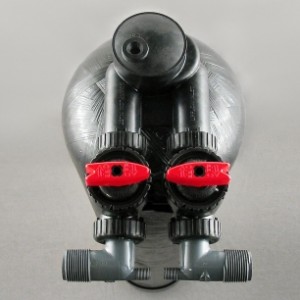
Basic Filtersorb Unit with Optional Bypass (red-handled valves). In this upflow system, water flows upward from the bottom of the tank through the treatment media. No backwashing is required, so, unlike conventional water softeners, the Filtersorb system does not require water for backwash, rinse, or brine circulation.
FilterSorb units are made with only a few liters of high potency media in a large tank, so there is virtually no pressure drop. The larger-than-necessary tank enhances performance by allowing the Filtersorb media to fluidize freely and have more contact time with the water.
FilterSorb can be used in water temperatures from 38 to 194 F and up to a hardness of 75 grains, although sizing for the residential units offered on this page is for water up to 25 grains hardness. If your hardness exceeds 25 grains, please call for sizing advice.
FilterSorb can tolerate high salinity (up to >2000 grains). Acceptable pH range is 6.5 to 9.5. Maximum iron content recommended is 0.2 ppm, and maximum manganese 0.5 ppm. Up to 1.3 ppm copper can be tolerated, but the medium requires zero oil, phosphates, and hydrogen sulfide. Although Filtersorb is fairly chlorine tolerant, the life of the media will be prolonged if a carbon filter is installed in front of the scale prevention unit in city water or chlorinated well water applications.
Standard Filtersorb Treatment Unit with the optional bypass. No electricity or salt are needed. The standard Filtersorb unit is built in a Vortech mineral tank with an upflow Clack head.
Pure Water Products FilterSorb Prices for Residential Units
Free Shipping to Lower 48 US Addresses.
|
Unit Description
|
GPM Rating
|
Price
|
|
Filtersorb 8 X 44 with 3 liters of Filtersorb.
|
10
|
$677.00
|
|
Filtersorb 9 X 48 with 4 liters of Filtersorb
|
12
|
$884.00
|
|
Filtersorb 10 X 54 with 5 liters of Filtersorb
|
15
|
$1,075.00
|
There is an optional bypass valve sold with the unit for $37 (see the red-handled valve in the picture above).
The
The "Light Commecial" Reverse Osmosis Unit
by Gene Franks, Pure Water Products
Although small application RO systems, units in the 200 to 400 gallon-per-day range, are not new, they are definitely gaining in popularity. They are especially handy for small businesses that need a limited amount of high quality water. Although they are too small for most water vending or whole house applications, they work great for small private car wash or window washing applications, small restaurants that want great water for drinking, cooking, and making beverages, greenhouses, laboratories, coffee shops, company break rooms and cafeterias, etc.
Here are some general observations on the various brands available:
- Most are multi-membrane units. Two to four small membranes running in parallel is standard. One company's simple design advertizes two 100-gallon-per-day membranes for a 200 gpd unit, three membranes for 300 gpd, and five membranes for 500 gpd. This system works in theory but can be awkward in practice, especially when troubleshooting performance issues. A single, large membrane is probably a more practical arrangement.
- Most RO units in this class use at least two booster pumps to bump up water pressure to the membranes. This system works well, but can become an issue unless a single electronic shutoff system is used to start and stop the pumps together. When using small pumps on multiple membranes, the pumps usually put out less pressure than the theoretical expectation.
- Most use 2.5" X 20" filter housings (see all units pictured on this page), although standard 2.5" X 10" cartridges are offered as an option in a few systems. Standard cartridge arrangment is sediment, pre-carbon, and post-carbon, although a DI option for the postfilter is sometimes offered. Remineralizing cartridges are also getting popular.
- Standard in/out tubing is 3/8", but 1/4" is often used for interior connections.
- Some units come standard with pressurized storage tanks; some offer tanks as an option. Most small RO units in this class can be used either with a pressure tanks or an atmospheric tank.
- Most, but not all, come with such electronic control features as low pressure shutoff and high pressure shutoff. Some have electronic autoflush drainline flow restrictors.
- Other options include ledge faucets, mounting stands, TDS monitors, delivery (demand) pumps, and UV lamps.
Depending on your needs, the best system may be the simplest. Most RO units in this class depend on multiple electrical control components and there is a lot that can go wrong.
This 300 GPD unit uses a single membrane. Most systems in this category use multiple small membranes.
A multi-membrane arrangement (membranes mounted behind filter housings)
At Pure Water Products
GRO
Our Black and White reverse osmosis units now come with the Pentair 50/50 membrane as an optional upgrade. When you replace the membrane on your existing Black and White unit, we can also show you how to retrofit it with the GRO. The GRO is also available on our countertop RO unit. We've tested the GRO and used it on selected products. Performance and water savings are impressive.
Single Tank Aerators
Single tank aeration filters for treatment of iron, manganese, and hydrogen sulfide continue to grow in popularity. We offer a wide selection of single tank aeration systems in popular sizes up to 13" X 54" with a variety of media--Birm, Katalox Light, catalytic carbon, ChemSorb, Calcite, and more. Single tank aerators are a quick, compact, inexpensive solution for many common well water problems. They are easy to install and require little upkeep and no chemicals.
Big Bubba
Big Bubba, the Watts large cartridge filter, has been a popular item this year. It's a high flow sediment filter capable of handling up to 150 gallons per minute service flow with pleated cartridges. A pleated carbon cartridge is also available for residential chlorine reduction up to 15 gallons per minute.
Big Bubba
Please visit our RO Parts Page for tanks and accessories. We also have dedicated parts pages for countertop water filters, undersink filters, and aeration equipment. We stock parts for everything we sell.
Thank you for reading. Please come back next week.
Places to Visit on Our Websites:
Garden Hose Filters. Don’t be the last on your block to own one. And don't forget that National Garden Hose Day is just around the corner.
Model 77: “The World’s Greatest $77 Water Filter”
”Sprite Shower Filters: You’ll Sing Better!”
Write to the Gazette or the Occasional: pwp@purewaterproducts.com
Please Visit
The Pure Water Gazette – now with an up-to-the-minute feed of the latest water news.
![occasionalbanner300[1]](https://ymlp.com/https.php?id=purewatergazette.net/blog/wp-content/uploads/2013/04/occasionalbanner3001.gif)






